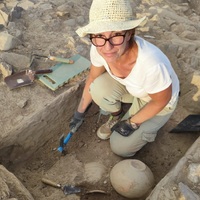Phone: ++49-761-2033386
Address: Institut für Archäologische Wissenschaften
Abteilung Urgeschichtliche Archäologie
Universität Freiburg
Belfortstraße 22
79085 Freiburg
Address: Institut für Archäologische Wissenschaften
Abteilung Urgeschichtliche Archäologie
Universität Freiburg
Belfortstraße 22
79085 Freiburg
less
Related Authors
Philipp Wolfgang Stockhammer
Ludwig-Maximilians-Universität München
Marta Diaz-Guardamino
Durham University
Miljana Radivojević
University College London
Enrico Cirelli
Università di Bologna
Katharina Rebay-Salisbury
University of Vienna
Helen De Cruz
Oxford Brookes University
John Sutton
Macquarie University
Kristian Kristiansen
University of Gothenburg
Marie Louise Stig Sørensen
University of Cambridge
Yannis Hamilakis
Brown University
InterestsView All (7)











Uploads
Books by Christoph Huth
Papers by Christoph Huth
Paleolithic to the present day. Manifold intentions led to the deposition of artifacts. Archaeologically, only the final stage of
a find at the time of deposition is visible. However, it has to be assumed that sometimes the artifacts or collections of objects
may have had a long history before they were deposited. In the true sense of the word, treasures serve to be stored and
occasionally also displayed as an expression of economic, political or religious wealth, but not to be buried in the ground.
as in religious terms. In contrast, patterns in the way of interpreting hoards rather seem to mirror preconceptions of what the Bronze Age world would have looked like. A less dogmatic approach in explaining fragmentation in Late Bronze Age hoards is suggested.
échange.
Keywords: Metal production, Late Bronze Age, copper mine, copper ingot, recycling, hoard, scrap hoard, fragmentation, exchange.
Herrschaftsansprüche über den Besitz von mediterranen Luxusgütern geltend gemacht wurden und Frauen allenfalls eine
nachrangige Bedeutung zukam. Übersehen wurde dabei die Vielzahl weiblicher Prunkbestattungen und die Häufigkeit
weiblich konnotierter Beigaben in den Gräbern. Anhand von archäologischen, bildlichen und historischen Quellen wird
versucht, die Rolle der Frau bei der Legitimation von Herrschaft in der frühen Eisenzeit nachzuzeichnen. Eine besondere
Bedeutung nahmen augenscheinlich Spendegefäße und Textilien in den Grabinventaren ein. Sie erinnerten offenbar an eine
heilige Hochzeit, mit der die Familienverbände ihre Machtansprüche über ihre Matrilinie herleiteten. In der Tat sind die
Grabinventare keine personenbezogenen Ansammlungen von Reichtümern, sondern aufwändige Inszenierungen solcher
mythologischer Ereignisse.
In any case, the staging in the graves had to follow a convincing logic that was present to contemporaries. Günter Dux analyzed its main features from a historical-sociological point of view and described it as subjectivist logic of action. Alan Strathern, Marshall Sahlins and Philippe Descola coined the term immanentism from a historical and ethnological perspective.
The heuristic potential of these approaches, so far largely neglected in archeology, is remarkable. They plausibly explain many features of Iron Age burials, such as the representation of divine ancestry and limitless abundance, of heroism and sacred marriage, of nature and culture and the order of the world. The logic of this worldview also grants insights into previously poorly understood features of early Iron Age religious ideas, such as the striking lack of depictions of gods, the lack of fixed places of worship (temples) with their own festival calendar, the specific forms of self-portrayal of "elites" and the close connection of rulership and specific groups of persons.
a central element of religious acts and notions of their time.
early Iron Age burials. However, little attention is paid to textiles and objects that are associated with spinning and
weaving. There is strong evidence that textiles did play an essential role in these burials. Many graves do contain
elements of cloth and weaving materials, like spindle whorls, loom-weights, distaffs and occasionally even a
whole weaving loom. Pictorial representations of wedding scenes must be mentioned in this context, too, as well
as images of textiles and weaving equipment, like fi bulae with pendants in the shape of weaving looms. The textile
decoration of belt plates and ceramic vessels deserve special consideration. Pictorial representations as well as
textiles and their manufacturing equipment seem to tell a story of highly symbolic signifi cance, in which death and
burial are staged like a wedding.
Textiles and their imagery can be found in almost all well-equipped graves, even in the Low Countries.
Most princely burials contain precious textiles that were used to enshroud the grave goods. In addition,
weaving and other forms of manufacturing are a common motif in pictorial representations from Italy to
the south-east Hallstatt groups. Weaving equipment like distaffs, spindle whorls, bobbins and the like is
a standard feature of Villanovan and Hallstatt graves. In south-west Central Europe bronze belts clearly
imitate textile patterns. This is also the case with the richly decorated pots of the so-called Alb-Hegau style,
while further to the east ceramic pots display stylized forms of weaving looms. The Alb-Hegau decoration
possibly mimics real textiles which were used to wrap grave-goods in rich burials. It is suggested that textile
elements in burials refer to the high standing of women in Early Iron Age society. A case is made that
burials are staged like a marriage, with drinking and textiles as core symbols. The rich burials of the Low
Countries fit perfectly well into this Early Iron Age ideology. Insofar that they are by no means a peripheral
phenomenon.
discusses various aspects of the metal finds dredged from the river – their quality and quantity, the circumstances
of their discovery and their distribution in space and time – and proposes the notion of the river as a border
zone between different spheres of the Bronze Age world. The liminal character of the Rhine as a frontier between
the world of the living and the other-world is particularly evident in the deposition of metal objects in the river.
This practice is placed in a long-term perspective by comparing the river finds of the Bronze Age with religious
sites of the Iron Age. Brief mention is made of the potential of contextualising archaeological finds of all kinds
(depositions, settlements, burials) in the geographical, geological and environmental data.
Paleolithic to the present day. Manifold intentions led to the deposition of artifacts. Archaeologically, only the final stage of
a find at the time of deposition is visible. However, it has to be assumed that sometimes the artifacts or collections of objects
may have had a long history before they were deposited. In the true sense of the word, treasures serve to be stored and
occasionally also displayed as an expression of economic, political or religious wealth, but not to be buried in the ground.
as in religious terms. In contrast, patterns in the way of interpreting hoards rather seem to mirror preconceptions of what the Bronze Age world would have looked like. A less dogmatic approach in explaining fragmentation in Late Bronze Age hoards is suggested.
échange.
Keywords: Metal production, Late Bronze Age, copper mine, copper ingot, recycling, hoard, scrap hoard, fragmentation, exchange.
Herrschaftsansprüche über den Besitz von mediterranen Luxusgütern geltend gemacht wurden und Frauen allenfalls eine
nachrangige Bedeutung zukam. Übersehen wurde dabei die Vielzahl weiblicher Prunkbestattungen und die Häufigkeit
weiblich konnotierter Beigaben in den Gräbern. Anhand von archäologischen, bildlichen und historischen Quellen wird
versucht, die Rolle der Frau bei der Legitimation von Herrschaft in der frühen Eisenzeit nachzuzeichnen. Eine besondere
Bedeutung nahmen augenscheinlich Spendegefäße und Textilien in den Grabinventaren ein. Sie erinnerten offenbar an eine
heilige Hochzeit, mit der die Familienverbände ihre Machtansprüche über ihre Matrilinie herleiteten. In der Tat sind die
Grabinventare keine personenbezogenen Ansammlungen von Reichtümern, sondern aufwändige Inszenierungen solcher
mythologischer Ereignisse.
In any case, the staging in the graves had to follow a convincing logic that was present to contemporaries. Günter Dux analyzed its main features from a historical-sociological point of view and described it as subjectivist logic of action. Alan Strathern, Marshall Sahlins and Philippe Descola coined the term immanentism from a historical and ethnological perspective.
The heuristic potential of these approaches, so far largely neglected in archeology, is remarkable. They plausibly explain many features of Iron Age burials, such as the representation of divine ancestry and limitless abundance, of heroism and sacred marriage, of nature and culture and the order of the world. The logic of this worldview also grants insights into previously poorly understood features of early Iron Age religious ideas, such as the striking lack of depictions of gods, the lack of fixed places of worship (temples) with their own festival calendar, the specific forms of self-portrayal of "elites" and the close connection of rulership and specific groups of persons.
a central element of religious acts and notions of their time.
early Iron Age burials. However, little attention is paid to textiles and objects that are associated with spinning and
weaving. There is strong evidence that textiles did play an essential role in these burials. Many graves do contain
elements of cloth and weaving materials, like spindle whorls, loom-weights, distaffs and occasionally even a
whole weaving loom. Pictorial representations of wedding scenes must be mentioned in this context, too, as well
as images of textiles and weaving equipment, like fi bulae with pendants in the shape of weaving looms. The textile
decoration of belt plates and ceramic vessels deserve special consideration. Pictorial representations as well as
textiles and their manufacturing equipment seem to tell a story of highly symbolic signifi cance, in which death and
burial are staged like a wedding.
Textiles and their imagery can be found in almost all well-equipped graves, even in the Low Countries.
Most princely burials contain precious textiles that were used to enshroud the grave goods. In addition,
weaving and other forms of manufacturing are a common motif in pictorial representations from Italy to
the south-east Hallstatt groups. Weaving equipment like distaffs, spindle whorls, bobbins and the like is
a standard feature of Villanovan and Hallstatt graves. In south-west Central Europe bronze belts clearly
imitate textile patterns. This is also the case with the richly decorated pots of the so-called Alb-Hegau style,
while further to the east ceramic pots display stylized forms of weaving looms. The Alb-Hegau decoration
possibly mimics real textiles which were used to wrap grave-goods in rich burials. It is suggested that textile
elements in burials refer to the high standing of women in Early Iron Age society. A case is made that
burials are staged like a marriage, with drinking and textiles as core symbols. The rich burials of the Low
Countries fit perfectly well into this Early Iron Age ideology. Insofar that they are by no means a peripheral
phenomenon.
discusses various aspects of the metal finds dredged from the river – their quality and quantity, the circumstances
of their discovery and their distribution in space and time – and proposes the notion of the river as a border
zone between different spheres of the Bronze Age world. The liminal character of the Rhine as a frontier between
the world of the living and the other-world is particularly evident in the deposition of metal objects in the river.
This practice is placed in a long-term perspective by comparing the river finds of the Bronze Age with religious
sites of the Iron Age. Brief mention is made of the potential of contextualising archaeological finds of all kinds
(depositions, settlements, burials) in the geographical, geological and environmental data.